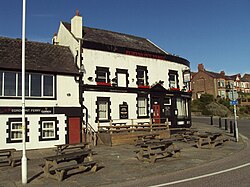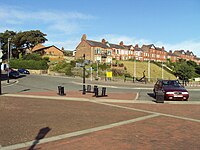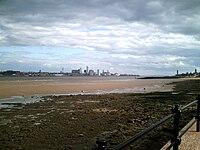Egremont, Cheshire: Difference between revisions
Created page with '{{Infobox town |name=Egremont |county=Cumberland |picture=Egremont Ferry pub 090809.JPG |picture caption=Egremont Ferry pub |os grid ref=SJ317923 |latitude=53.4236 |longitude=-3.…' |
No edit summary |
||
| Line 1: | Line 1: | ||
{{Infobox town | {{Infobox town | ||
|name=Egremont | |name=Egremont | ||
|county= | |county=Cheshire | ||
|picture=Egremont Ferry pub 090809.JPG | |picture=Egremont Ferry pub 090809.JPG | ||
|picture caption=Egremont Ferry pub | |picture caption=Egremont Ferry pub | ||
Latest revision as of 22:06, 14 May 2017
| Egremont | |
| Cheshire | |
|---|---|
 Egremont Ferry pub | |
| Location | |
| Grid reference: | SJ317923 |
| Location: | 53°25’25"N, 3°2’15"W |
| Data | |
| Post town: | Wallasey |
| Postcode: | CH44 |
| Dialling code: | 0151 |
| Local Government | |
| Council: | Wirral |
| Parliamentary constituency: |
Wallasey |
Egremont is an area of the town of Wallasey in Cheshire, standing by the shore on the Wirral Peninsula. It is bordered by New Brighton to the north, Liscard to the west and Seacombe to the south.
History
Egremont was considered part of the Liscard township until the 1820s, when expansion of Liscard was deemed significant enough that it should be split into two townships.
One of the earliest buildings in Egremont was the Liscard Manor House, also known as the 'Seabank'. Dating back to the 1790s, it was home to the influential Penkett and Maddock families. The area which grew up around Seabank was eventually to become the Mariners' home founded in 1892 by William Cliff.
The name of the area was decided by one Captain Askew who built a house in the area as early as 1835 and named the village 'Egremont' after his birthplace; Egremont, Cumberland.
Egremont Ferry was built in 1827 and was the longest pier on Merseyside until its dismantlement in 1946 due to a coaster having crashed into it, causing irreparable damage.
The MV Egremont, an ex-Mersey Ferry named for the town is still in use today, having been converted to a floating base for the Island Cruising Club, based in Salcombe, Devon to operate sailing courses from.[1]
Description


Today three and four-bedroomed, largely working class terraced houses and semi-detached homes dominate Egremont. A small shopping area is located along King Street, the main road of the district. Egremont's river frontage is part of the promenade which, under various names, runs as an unbroken traffic-free pedestrian route from Seacombe Ferry to New Brighton, and is the best place from which to view the panoramic skyline of Liverpool.
The central point of Egremont Promenade is the site of the Egremont Ferry, reached from Tobin Street. For a number of years there was a building there known locally as 'The Beehive'. This building began life as a police station before the interiors and exterior panels were ripped out leaving only a brick frame and tiled roof. There were other structures too which were probably part of the ferry buildings. Before their demolition in 1983, these buildings served as homes to a boat yard, the base for a motorboat club and also the infamous 'Davy Jones Locker' club. To either side of this minor promontory there is access to the sea-shore, which was very popular with locals and trippers for some decades after Second World War. One of the most prominent buildings visible from the promenade is Wallasey Town Hall. This large building is reached by road from Brighton Street, or via a lengthy flight of steps from the promenade.
John Tobin is known for the road Tobin Street, by the Egremont Ferry, leading down to the promenade. He owned from Tobin Street to Kinglake Road and between Wright Street, before the housing estate was built. He bought the land and invested to build the houses in Kinglake and Wright Street. His home was located in what is now Central Park. Before it was a park it was John Tobin's private land. When he died he gave the land to the community. By the early 21st century his house had become derelict and was subsequently demolished in 2009.
References
- ↑ Island Cruising Club, http://www.icc-salcombe.co.uk/, retrieved 2009-03-11